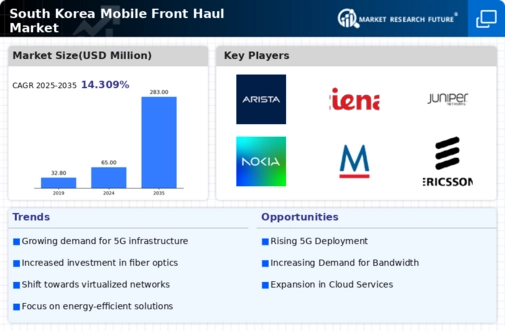The mobile front-haul market in South Korea is characterized by a dynamic competitive landscape, driven by rapid technological advancements and increasing demand for high-speed connectivity. Key players such as Samsung (Korea), Nokia (Finland), and Ericsson (Sweden) are at the forefront, each adopting distinct strategies to enhance their market positioning. Samsung (Korea) focuses on innovation in 5G technology, leveraging its extensive R&D capabilities to develop cutting-edge solutions. Meanwhile, Nokia (Finland) emphasizes strategic partnerships and acquisitions to bolster its service offerings, particularly in network optimization and automation. Ericsson (Sweden) is also heavily invested in digital transformation initiatives, aiming to streamline operations and enhance customer experiences through advanced analytics and AI integration. Collectively, these strategies contribute to a competitive environment that is increasingly centered around technological innovation and strategic collaborations.
In terms of business tactics, companies are localizing manufacturing and optimizing supply chains to enhance operational efficiency. The market structure appears moderately fragmented, with several key players vying for dominance. This fragmentation allows for a diverse range of solutions and services, fostering competition that drives innovation. The collective influence of these major companies shapes the market dynamics, as they continuously adapt to evolving consumer demands and technological advancements.
In October 2025, Samsung (Korea) announced a significant partnership with a leading telecommunications provider to deploy its latest 5G front-haul solutions across urban areas. This strategic move is expected to enhance network performance and reliability, positioning Samsung as a key player in the ongoing 5G rollout. The partnership underscores Samsung's commitment to expanding its footprint in the mobile front-haul market while addressing the growing demand for high-speed connectivity.
In September 2025, Nokia (Finland) completed the acquisition of a software company specializing in network automation. This acquisition is poised to enhance Nokia's capabilities in providing automated solutions for mobile front-haul networks, thereby improving operational efficiency for its clients. The strategic importance of this move lies in Nokia's aim to lead the market in automation, which is increasingly becoming a critical factor for telecom operators seeking to optimize their networks.
In August 2025, Ericsson (Sweden) launched a new suite of AI-driven analytics tools designed to optimize network performance in real-time. This initiative reflects Ericsson's focus on integrating AI into its service offerings, enabling telecom operators to make data-driven decisions that enhance service quality. The introduction of these tools is likely to strengthen Ericsson's competitive position by providing clients with advanced capabilities to manage their networks more effectively.
As of November 2025, current trends in the mobile front-haul market include a pronounced shift towards digitalization, sustainability, and AI integration. Strategic alliances are increasingly shaping the competitive landscape, as companies recognize the value of collaboration in driving innovation. Looking ahead, competitive differentiation is expected to evolve, with a greater emphasis on technological advancements and supply chain reliability rather than solely on price. This shift indicates a maturation of the market, where innovation and quality will play pivotal roles in determining success.


















Leave a Comment